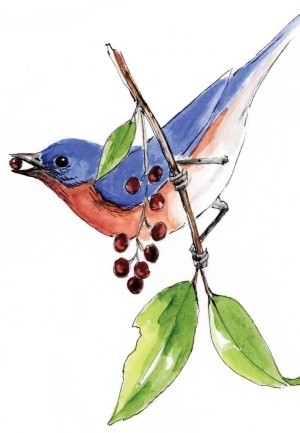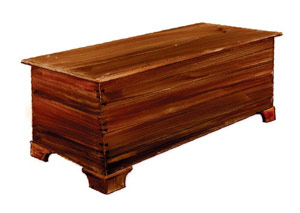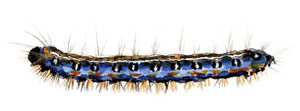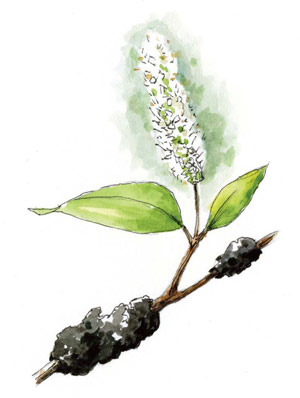
Black cherry, Prunus serotina
Black cherry grows in many different situations: among white pine on abandoned farmland, with red maple on poor sites, and scattered among northern hardwoods in richer situations. The fact that it at least tries to grow everywhere is fortunate for wildlife. The bright red cherries (later turning to a dark purple) are reportedly eaten by 81 wildlife species. In addition to its popularity with fruit eaters, cherry’s twigs are browsed by deer, moose, and hare, and its bark attracts porcupines.
Chokecherry, pin cherry, and black cherry are quite similar as seedlings, and all cherry bark has a bitter almond taste. Chokecherry, however, is a mere shrub, and pin cherry rarely grows to more than 25 feet high, so black cherry is the only large forest tree of the three. Unlike its sister species, the leaves of black cherry have fuzz, ranging from white to brown, on both sides of the midrib on the underside of the leaf. By the time black cherry trees have grown to a diameter of five inches, the bark is unlike any other. It looks like potato chips that have been burned to a dark purplish gray, almost to black.
Where deer are abundant, as they are in Pennsylvania, black cherry can be hard to regenerate. But when deer numbers are not sky high and more palatable maple and ash seedlings are available, stands with a good amount of cherry are not uncommon. It’s long been noted that black cherry rarely grows in pure stands, and the reason for this came to light only after people noticed that in Europe, where it’s an invasive species, it’s happy to grow as a monoculture. It seems that there is an aggressive soil pathogen associated with black cherry roots in the U.S. that prevents other cherries from growing nearby. That deterrent did not travel to Europe, where black cherry is considered a true menace because it out competes many native trees and shrubs.

Wood
The best black cherry sawtimber comes from the Alleghany Plateau, which covers parts of Pennsylvania, New York, and West Virginia. There this tree grows 100 feet high and commonly to two feet in diameter. In contrast, a New England black cherry tree can be somewhat scraggly looking. A spindly trunk wobbles upwards, and the crown, often the highest one around, has sparse foliage.
The wood is so cherished that much of it was cut long ago and used for furniture, for paneling in houses, and in countless streetcars. Once it has seasoned, the wood does not change size or shape. It is so stable that it was used for airplane propellers early in this century and for patterns and carpenters’ levels. You will have to search to find a woodworker willing to say a word against it. Perfect joinery is possible because the wood has excellent machining qualities, is straight-grained, sands well, does not warp, check, or chip, and takes finishes without complaint.
Nonetheless, for a time, cherry’s reputation was eclipsed by imported mahogany, and it was sometimes stained and sold as American mahogany, a practice one writer called “gilding the lily with mud.” Today, cherry costs more than mahogany, so other species, such as black birch, are stained to imitate cherry. Few would be fooled, though, for no mere stain can impart the deep reddish glow that seems to come from deep within cherry wood.

Eastern tent caterpillars
Although the foliage is toxic to people and livestock, black cherry is a go-to plant for more than 200 moth and butterfly species. The eastern tent caterpillar (Malacosoma americanum) is the most noticeable pest. Its silken nests have inspired the wrath of homeowners for centuries. The sun-loving insects often are found
along roads and around houses, where their messy living quarters and early spring defoliation are all too obvious. A native insect, the species was noted in this country as early as 1646, and since then people have poisoned it, burned its tents, and pruned away and destroyed its egg masses. The caterpillars are still with us.
Why would caterpillars live communally as these do, putting all their eggs, as it were, in one basket – an easy target not just for homeowners but also for birds or anyone else with a taste for Lepidopteron larvae?
One reason is that the tents are cozy. It’s still chilly in early May, when the larvae leave the egg mass and begin to feed on newly emerging leaves, and these animals fare the best and gain the most weight when it’s 77-86°F, considerably above the average outdoor readings at that time of year. Just as in a greenhouse, the temperature inside a tent caterpillar tent is typically 35-45°F warmer than it is outside. Nests are oriented southeast to southwest to capture the most sun.

Black knot
Wherever cherries grow, so does black knot (Apiosporina morbosa), one of the most conspicuous of all tree diseases. Elongated, black, misshapen galls surround the twigs, making badly affected trees look miserable, as though the contents of several pooper scoopers had been flung into their branches.
The disease only infects woody plants in the genus Prunus, so when you learn to recognize the fungus, you’ve also identified a peach, plum, almond, or cherry. Chokecherry and pin cherry, as well as black cherry, can all be found with unsightly black lumps in their branches.
In spring, when tender green shoots have grown to be about an inch long, when the trees are flowering, and when all seems right with the world, spores of the fungus are splashed by rain onto the new growth. Infection begins when a spore germinates and penetrates the growing shoot. Fungal tissue multiplies within the twig throughout the growing season, but no symptoms are visible until late summer, when a swelling of the branch occurs. Growth of the knot stops in winter, and when it resumes in spring, the surface bark splits, revealing the olive-green fungus. By the end of the second winter the knot is black, a black that is intensified by myriad black spores that will ripen and be released the following spring.

